Brick ID
- Thread starter ecampbell
- Start date
You are using an out of date browser. It may not display this or other websites correctly.
You should upgrade or use an alternative browser.
You should upgrade or use an alternative browser.
Jerseyman......I am so sorry.....the Valentine has " X X ", not a " I I ". I hope you still find it interesting. Woodbridge also seems to be written on the front as well. Thank you for letting me share and thanks again for your short course on NJ brick!
View attachment 557
Turtle:
It is still a brick—so of course I would find it interesting. I thought, perhaps, that you had a stamped brick I had not seen before (with the “II” marking), but since the brick exhibits the usual “XX” I feel much better!!
Like the Ostrander brick that started off this thread, your Valentine is also a firebrick, manufactured from the finest fireclay in the world, excavated in Woodbridge, New Jersey. As early as the late 1850s, brick manufactories in the Woodbridge area were already producing almost 80 million fire bricks per annum. Brothers M.D. Valentine and James R. Valentine established their brickyard here in 1866. Within ten years, the works manufactured four million bricks annually. Eventually, the refractory producer A.P. Green assumed control of the Valentine factory and continued shipping Valentine XX firebrick for many years.
Best regards,
Jerseyman
Jerseyman, revisiting the "SB" mark for a second... wouldn't it be possible the brick came from the Somers Brick company in Northfield? I took this picture in Birch Grove Park, which is the site and mine for the company back around the turn of the 20th century:
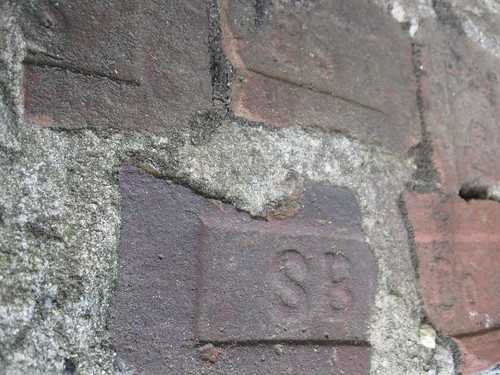
http://www.flickr.com/photos/22516573@N07/2880750569/
It does have "Co" at the other end, but perhaps the brick from the park had broken in half like the one above? Very interesting and informative thread here.
Michael

http://www.flickr.com/photos/22516573@N07/2880750569/
It does have "Co" at the other end, but perhaps the brick from the park had broken in half like the one above? Very interesting and informative thread here.
Michael
I've seen quite a few of those Valentine bricks at the site of the Chester Furnace in Chester, NJ. Unfortunately no whole specimens.
Jerseyman, revisiting the "SB" mark for a second... wouldn't it be possible the brick came from the Somers Brick company in Northfield? I took this picture in Birch Grove Park, which is the site and mine for the company back around the turn of the 20th century:

http://www.flickr.com/photos/22516573@N07/2880750569/
It does have "Co" at the other end, but perhaps the brick from the park had broken in half like the one above? Very interesting and informative thread here.
Michael
Michael:
Well, you learn something new every day! I knew about the existence of the Somers Brick Company, but I never knew they stamped their brick with identifying initials, so I really appreciate your photograph!! If Tom could supply a photograph of his brick, we could ascertain whether it is from Somers or Sacramento, because the Somers brick featured lettering stamped into a raised panel while the Sacramento Brick stamped their products with what was known as a frog—essentially an inset panel surrounded by a frame or line.
Thanks, Michael!
Best regards,
Jerseyman
I have found a brick with "somers" stamped onto it. Perhaps they switched either to or from the "SB" at some point?
Hey jerseyman
The Bricks I have are stamped with the frog as you call inset with a raised line around the edge. Sorry i can't supply a pic , i don't have a digital or the means to down load it . I might try a friend ,maybe they could take the pic and send it to me then i'll upload it for you
The Bricks I have are stamped with the frog as you call inset with a raised line around the edge. Sorry i can't supply a pic , i don't have a digital or the means to down load it . I might try a friend ,maybe they could take the pic and send it to me then i'll upload it for you
Hey jerseyman
The Bricks I have are stamped with the frog as you call inset with a raised line around the edge. Sorry i can't supply a pic , i don't have a digital or the means to down load it . I might try a friend ,maybe they could take the pic and send it to me then i'll upload it for you
No problem, Tom. If you can borrow a digital camera—great! If not, don’t worry about it. Whether your brick came from Sacramento or Northfield, I have learned something new about Somers Brick, for which I am very grateful to both Mts83 and Pinelandpaddler.
Best regards,
Jerseyman
Hey jerseyman
The Bricks I have are stamped with the frog as you call inset with a raised line around the edge. Sorry i can't supply a pic , i don't have a digital or the means to down load it . I might try a friend ,maybe they could take the pic and send it to me then i'll upload it for you
Hey Tom, are you working this Friday? I'm off, I can take a picture for you then. It's the down load part I need to figure out. I tried a few weeks ago to download some pictures I took at the old campsite, and it didn't work. I missed a step somewhere. Maybe we can figure it out.
Greg
Michael:
Well, you learn something new every day! I knew about the existence of the Somers Brick Company, but I never knew they stamped their brick with identifying initials, so I really appreciate your photograph!! If Tom could supply a photograph of his brick, we could ascertain whether it is from Somers or Sacramento, because the Somers brick featured lettering stamped into a raised panel while the Sacramento Brick stamped their products with what was known as a frog—essentially an inset panel surrounded by a frame or line.
Thanks, Michael!
Best regards,
Jerseyman
No problem Jerseyman, glad I could help! Birch Grove Park in Northfield today is a great spot to do some unexpectedly rural hiking, and of course check out the few remains scattered around from its brick making days. The elongated trenches are the lakes scattered around the park today.

http://www.flickr.com/photos/22516573@N07/2881582728
Somers Brick Company
Gabe, Michael, et al.:
I hope you can add to the information below, Michael, as Gabe has requested. This is what I have in my files:
The Somers Brick Company filed its incorporation papers with the New Jersey Secretary of State on 8 May 1900. The official corporate office for the company stood at the corner of Arctic and Missouri avenues and Warren Somers served as the agent for the firm. The company established its brickyard in Bakersville, the old name of the present-day City of Northfield. This was where workmen excavated the company’s raw material from a large clay deposit describable as part of the Cape May formation. The formation had three layers to it and an acceptable common brick could only be produced by blending the top and bottom clay layers, adding as little water as possible, and then forming the green brick under high pressure. Somers shipped much of its product to feed the building boom occurring in Atlantic City at that time. The manufacturing plant featured an Autobrik Machine for producing the green bricks. Manufactured by the Lancaster Iron Works, Incorporated, of Lancaster, Pennsylvania, the Autobrik required only one person to man its operations and the Lancaster Iron Works still manufactures these brick-making machines today. The machine had the capacity of tempering and pressing the clay, bumping the molds for uniformity, dumping the pressed green bricks on pallets, and then delivering the pallets to the trucks used to transport the brick to the next phase of the manufacturing process: the waste-heat, hot-air drying room, where the green brick was prepared to enter one of the eleven kilns at the Somers Brick Company. The Autobrik operation made it easy to stamp the brick with identifying initials or name. In its advertising literature, Lancaster noted, “Building brick made by the AutoBrik Machine is known as the “Common building brick with face brick characteristics.” Here is a view of an AutoBrik Machine:

And a view of the machine in operation:

The Somers Company used a Browning Engineering steam-powered clamshell bucket shovel, manufactured in Cleveland, to remove overburden and excavate the clay from the pits:

Somers employed a relatively large black labor force and provided the men with on-site housing. Recent Italian emigrants also worked for the brick company. In 1906, the Somers Brick Company employed 75 men; six years later, the payroll had increased to 100; and, in 1918, the number of workers further expanded to 150 men. Finally, in 1927, the workforce had dropped to 70 laborers and the company began throttling down towards its demise.
Here is a map of the yard in 1924:

By 1933, however, the Sanborn Map indicates the brickyard had already closed:

And by 1942, all of the manufacturing equipment and kilns had disappeared, with any metal elements probably going to the war effort:

After the brickyard closed during the Great Depression, the company could not pay its property taxes, so the City of Northfield gained control and ownership of the land through court action. A man named Engelbert Breunig led the charge to convert the former brickyard and its associated clay pits into a public space named Birch Grove Park. The city fathers dedicated the land as a park in August 1951 and opened the new facility in March 1952. When it first debuted, the park boasted of 29 lakes, created from the clay pits, with swimming and boating areas. Since then, the city has filled in several of the lakes. The park also featured a covered bridge at one time. As Michael has noted, the park can still be enjoyed today. The Northfield Historical Museum sits on or near the site of a Somers Brick Company kiln.
Best regards,
Jerseyman
Gabe, Michael, et al.:
I hope you can add to the information below, Michael, as Gabe has requested. This is what I have in my files:
The Somers Brick Company filed its incorporation papers with the New Jersey Secretary of State on 8 May 1900. The official corporate office for the company stood at the corner of Arctic and Missouri avenues and Warren Somers served as the agent for the firm. The company established its brickyard in Bakersville, the old name of the present-day City of Northfield. This was where workmen excavated the company’s raw material from a large clay deposit describable as part of the Cape May formation. The formation had three layers to it and an acceptable common brick could only be produced by blending the top and bottom clay layers, adding as little water as possible, and then forming the green brick under high pressure. Somers shipped much of its product to feed the building boom occurring in Atlantic City at that time. The manufacturing plant featured an Autobrik Machine for producing the green bricks. Manufactured by the Lancaster Iron Works, Incorporated, of Lancaster, Pennsylvania, the Autobrik required only one person to man its operations and the Lancaster Iron Works still manufactures these brick-making machines today. The machine had the capacity of tempering and pressing the clay, bumping the molds for uniformity, dumping the pressed green bricks on pallets, and then delivering the pallets to the trucks used to transport the brick to the next phase of the manufacturing process: the waste-heat, hot-air drying room, where the green brick was prepared to enter one of the eleven kilns at the Somers Brick Company. The Autobrik operation made it easy to stamp the brick with identifying initials or name. In its advertising literature, Lancaster noted, “Building brick made by the AutoBrik Machine is known as the “Common building brick with face brick characteristics.” Here is a view of an AutoBrik Machine:

And a view of the machine in operation:

The Somers Company used a Browning Engineering steam-powered clamshell bucket shovel, manufactured in Cleveland, to remove overburden and excavate the clay from the pits:

Somers employed a relatively large black labor force and provided the men with on-site housing. Recent Italian emigrants also worked for the brick company. In 1906, the Somers Brick Company employed 75 men; six years later, the payroll had increased to 100; and, in 1918, the number of workers further expanded to 150 men. Finally, in 1927, the workforce had dropped to 70 laborers and the company began throttling down towards its demise.
Here is a map of the yard in 1924:

By 1933, however, the Sanborn Map indicates the brickyard had already closed:

And by 1942, all of the manufacturing equipment and kilns had disappeared, with any metal elements probably going to the war effort:

After the brickyard closed during the Great Depression, the company could not pay its property taxes, so the City of Northfield gained control and ownership of the land through court action. A man named Engelbert Breunig led the charge to convert the former brickyard and its associated clay pits into a public space named Birch Grove Park. The city fathers dedicated the land as a park in August 1951 and opened the new facility in March 1952. When it first debuted, the park boasted of 29 lakes, created from the clay pits, with swimming and boating areas. Since then, the city has filled in several of the lakes. The park also featured a covered bridge at one time. As Michael has noted, the park can still be enjoyed today. The Northfield Historical Museum sits on or near the site of a Somers Brick Company kiln.
Best regards,
Jerseyman
I’m also once again amazed by the great information provided by Jerseyman, as well as inspired by this thread. I’ve collected old bricks wherever I picked them up for decades now. But I’ve merely used them for things like informal landscape edging, with little thought to their history. When I start my Spring yard work, I’ll certainly be examining each one more closely. 

I paid a visit to the Egg Harbor City Historical Society Museum today. they have a couple bricks on display that were part of the original Philadelphia Ave. Pretty cool. I wonder where they were made? Jerseyman?
I paid a visit to the Egg Harbor City Historical Society Museum today. they have a couple bricks on display that were part of the original Philadelphia Ave. Pretty cool. I wonder where they were made? Jerseyman?
Gabe:
It would be a little difficult to know who made the bricks and where without some type of identifying marks. Did the exhibit indicate the age of the bricks?
I know in March 1904, Egg Harbor City awarded a contract to the Atlantic City Concrete, Construction and Paving Company for paving intersections with concrete and vitrified bricks. Later, the city advertised for a contractor to construct vitrified brick gutters and curbing in 1916.
If you can provide me with the age of the bricks I might be able to find additional information.
Best regards,
Jerseyman
Gabe, Jerseyman:
Sorry it took a while to get back to this thread, unfortunately I don't have much to add as Jerseyman (fortunately ) added more than I could have ever supplied! The only other thing to add is that they had four different marks, "S&B Co" as my photo showed, "Somers" as was mentioned above I believe, and two others. "S&F Co" and "S&FB Co" were the others I believe. As to why some were filled in I believe it was an insurance liability in the 1950s, as when they first opened swimming and boating were even permitted in the park. Nowadays there is an exercise trail along with other regular hiking trails/bridges, and campground within the park. About the covered bridge, another was built in 1988 taking place of the former. One source of old photos, and info on Somers Brick company can be found in Arcadia Publishing's book "Northfield" found at Borders in the area. They have additonal pictures as well, many of which have already been supplied by Jerseyman though. As for how the park looks today, I've supplied a few more pictures below:
) added more than I could have ever supplied! The only other thing to add is that they had four different marks, "S&B Co" as my photo showed, "Somers" as was mentioned above I believe, and two others. "S&F Co" and "S&FB Co" were the others I believe. As to why some were filled in I believe it was an insurance liability in the 1950s, as when they first opened swimming and boating were even permitted in the park. Nowadays there is an exercise trail along with other regular hiking trails/bridges, and campground within the park. About the covered bridge, another was built in 1988 taking place of the former. One source of old photos, and info on Somers Brick company can be found in Arcadia Publishing's book "Northfield" found at Borders in the area. They have additonal pictures as well, many of which have already been supplied by Jerseyman though. As for how the park looks today, I've supplied a few more pictures below:
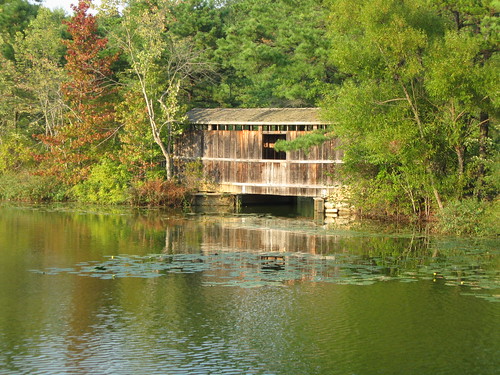
http://www.flickr.com/photos/22516573@N07/2883028281/
This was/is the Northfield garden club (The sign notes 1951- dating to the parks founding):
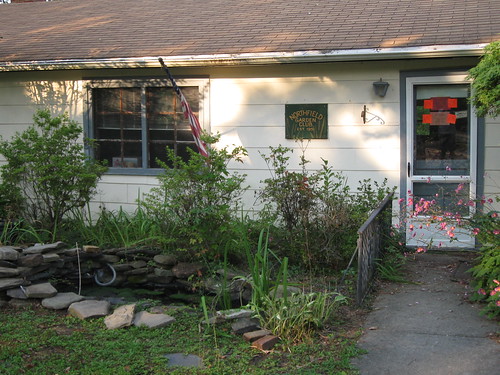
http://www.flickr.com/photos/22516573@N07/2887220886/
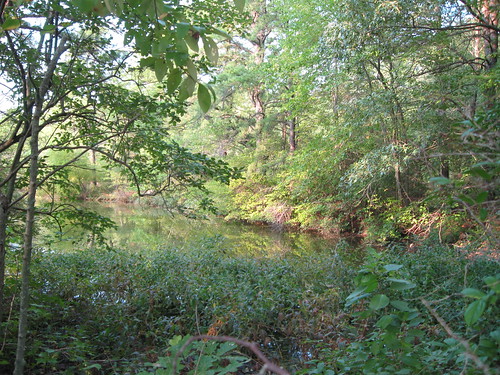
http://www.flickr.com/photos/22516573@N07/2883014055/
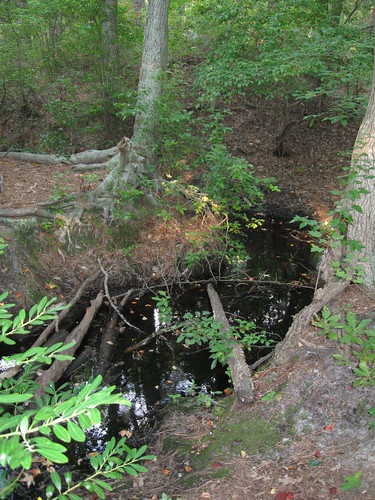
http://www.flickr.com/photos/22516573@N07/2883002437
Sorry it took a while to get back to this thread, unfortunately I don't have much to add as Jerseyman (fortunately
 ) added more than I could have ever supplied! The only other thing to add is that they had four different marks, "S&B Co" as my photo showed, "Somers" as was mentioned above I believe, and two others. "S&F Co" and "S&FB Co" were the others I believe. As to why some were filled in I believe it was an insurance liability in the 1950s, as when they first opened swimming and boating were even permitted in the park. Nowadays there is an exercise trail along with other regular hiking trails/bridges, and campground within the park. About the covered bridge, another was built in 1988 taking place of the former. One source of old photos, and info on Somers Brick company can be found in Arcadia Publishing's book "Northfield" found at Borders in the area. They have additonal pictures as well, many of which have already been supplied by Jerseyman though. As for how the park looks today, I've supplied a few more pictures below:
) added more than I could have ever supplied! The only other thing to add is that they had four different marks, "S&B Co" as my photo showed, "Somers" as was mentioned above I believe, and two others. "S&F Co" and "S&FB Co" were the others I believe. As to why some were filled in I believe it was an insurance liability in the 1950s, as when they first opened swimming and boating were even permitted in the park. Nowadays there is an exercise trail along with other regular hiking trails/bridges, and campground within the park. About the covered bridge, another was built in 1988 taking place of the former. One source of old photos, and info on Somers Brick company can be found in Arcadia Publishing's book "Northfield" found at Borders in the area. They have additonal pictures as well, many of which have already been supplied by Jerseyman though. As for how the park looks today, I've supplied a few more pictures below:
http://www.flickr.com/photos/22516573@N07/2883028281/
This was/is the Northfield garden club (The sign notes 1951- dating to the parks founding):

http://www.flickr.com/photos/22516573@N07/2887220886/

http://www.flickr.com/photos/22516573@N07/2883014055/

http://www.flickr.com/photos/22516573@N07/2883002437
Gabe, Jerseyman:
The only other thing to add is that they had four different marks, "S&B Co" as my photo showed, "Somers" as was mentioned above I believe, and two others. "S&F Co" and "S&FB Co" were the others I believe.
Michael:
I saw the reference to the other stamped identifiers on the bricks and I think the person who wrote that caption is simply incorrect. Bricks stamped “S&F Co.” and “S&FB Co.” have always been products of the firm of Sayre & Fisher, one of the mega brick producers along the Raritan River in Middlesex County.
Thank you for the present-day photographs—it truly is a beautiful park area!!
Best regards,
Jerseyman
Here is a website about the history of the Sayre and Fisher Brick Company. Pretty interesting stuff.
http://sayre-fisher.com/default.htm
http://sayre-fisher.com/default.htm
Michael:
I saw the reference to the other stamped identifiers on the bricks and I think the person who wrote that caption is simply incorrect. Bricks stamped “S&F Co.” and “S&FB Co.” have always been products of the firm of Sayre & Fisher, one of the mega brick producers along the Raritan River in Middlesex County.
Thank you for the present-day photographs—it truly is a beautiful park area!!
Best regards,
Jerseyman
Jerseyman, thanks for the correction. When I read that I figured something may have been up as I couldn’t figure out what the "F" stood for, I just took it as being correct since it was printed in the book. Sayre & Fisher makes sense. Thanks for the comments on the present day photos, it really is amazing how you can around there in the middle of the afternoon in an environment like that while only a mile away or less are the traffic clogged streets of Fire Rd and Route 9. Its interesting to see what Northfield looked like at one time long ago.


